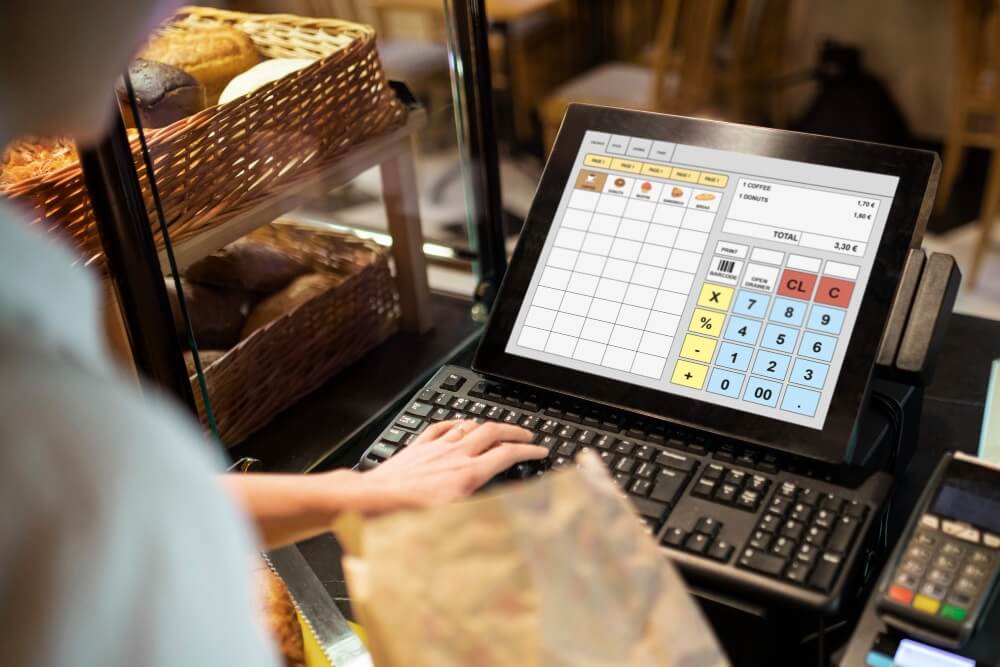Operating a cash register (or modern POS) is a core retail skill. Beyond ringing sales, registers process payments, print receipts, track inventory, and create sales reports that managers rely on. With rising contactless payments and cloud POS systems, cashiers should understand both classic cash handling and modern digital workflows to keep lines moving and records clean.
Why this matters now (quick market context)
Modern POS systems are a major and growing part of retail infrastructure. The global point-of-sale market was valued at about USD 33.4 billion in 2024, with strong growth projected into 2025 and beyond.
Contactless payments and mobile wallets have become mainstream: in many regions the majority of POS terminals now accept contactless transactions, and the value of contactless payments is rising sharply.
Small businesses are adopting POS software quickly — cloud, inventory and payments features are common now — so learning POS basics is essential for modern cashiers.

What is a cash register (and how it links to POS)?
A cash register records sales, stores cash, and prints receipts. Modern registers are usually part of broader Point-of-Sale (POS) systems that also handle inventory, customer data, discounts, and reporting. Typical components include the cash drawer, barcode scanner, receipt printer, touchscreen or keyboard, and card reader (for chip, swipe, tap, and mobile wallet payments).
Quick setup checklist (start of shift)
- Count your opening cash (float). Verify denominations and enter the opening amount into the system so daily reconciliation matches the drawer.
- Check hardware. Ensure receipt paper is loaded, scanner scans barcodes, and the card terminal is connected and shows network/approval status.
- Log in securely. Use your cashier PIN or credentials so transactions are tracked to your shift.
- Run a system check. Confirm network connectivity (especially for card approvals) and pull a quick sales summary from previous shift if required.
Running a sale — step-by-step
- Scan or enter items. Scan each barcode; if an item lacks a barcode, enter SKU or price manually. Confirm quantities and any automatic discounts.
- Apply discounts or coupons. Scan coupon barcodes or enter promo codes. Verify expiration or member status if required.
- Accept payment. For cash, enter amount received and give exact change; for cards, ensure the terminal authorizes before completing. Support contactless (tap/phone/watch) where available.
- Offer receipt options. Print, email, or SMS the receipt per customer preference and ask if they need a bag or help.
- Close the sale. Ensure the transaction completes in the POS and that inventory count is updated if your system tracks stock.

Handling different payment type
- Cash: Count bills openly, return change while confirming amounts aloud (e.g., “That’s $5.00 change — two twos and a one”).
- Card: Wait for authorization and ensure chip/EMV or contactless confirmation before handing a receipt.
- Mobile wallets (Apple Pay/Google Pay): Ensure the terminal indicates successful token authorization.
- Split payments: Follow your POS workflow — many systems allow part cash/part card in a single transaction.
Voids, refunds, and returns
- Voids: If an error occurs before closing the sale, use the register’s void function. High-value voids often require manager approval.
- Refunds: Verify receipt, check return policy, and use the refund workflow. If the original payment method isn’t available, follow store policy (store credit / manager approval).
- Exchanges: Process the return first, then ring up the new items to keep records accurate.
Troubleshooting common issues
- Card terminal decline: Try re-swipe or re-insert; ask customer to try another card or use mobile wallet. If network is down, follow store’s offline card policy.
- Scanner won’t read: Manually enter SKU/PLU. Keep a printed price list for common no-barcode items.
- Receipt jam or out of paper: Replace paper roll, clear jam carefully, and reprint receipt if needed.
Managing the cash drawer securely
- Minimize openings: Only open for payments or cash counts to reduce theft risk.
- End-of-shift count: Reconcile drawer totals with POS totals. Report any discrepancies immediately. Accurate cash handling builds trust and avoids disciplinary action.
- Safe drops: For large bills, follow your store’s safe-drop policy to move excess cash from drawer to safe during shift.

Customer service and error handling
Stay calm and polite when errors occur. Explain steps: “I’ll void that and re-ring it for you.” Use clear language and offer solutions (manager override, resend receipt, small discount if policy allows). Good service reduces complaints and improves retention.
Is it hard to learn a cash register?
No — the basics are straightforward, but speed and accuracy come with practice. Key skills: multitasking, attention to detail, and friendly communication. Spend time learning common PLUs, discount codes, and the store’s return policies to reduce slowdowns.
Safety and fraud prevention
- Verify large returns and suspect payments with manager review.
- Look for card skimming signs and report terminal tampering.
- Follow ID rules for high-risk sales (age-restricted items). Preventing fraud protects both the store and your job.
Modern trends cashier should know (2024–2025)
- POS growth and cloud adoption: POS market value and cloud adoption have grown strongly, meaning more features (inventory, analytics) are moving into cashier workflows.
- Contactless and mobile payments are now dominant in many markets; terminals increasingly accept tap and wallet payments. High contactless acceptance reduces cash handling but requires updated terminal use.
- Data and integrations: Modern POS links to loyalty programs and online orders — cashiers often need to look up customer profiles or apply online promotions at the register.

FAQs
How do I count the cash drawer at the start and end of shift?
Count bills and coins by denomination, enter the starting float into the POS at shift start, and at close count total drawer and compare to POS Z-report. Report discrepancies per store policy.
What do I do if a card is declined?
Politely inform the customer, ask for another payment method, and retry according to POS prompts. If network issues persist, follow your store’s offline card acceptance policy or ask a manager.
Can I void transactions without manager approval?
Small item voids are usually allowed; large voids or refunds typically require manager approval. Follow your store’s thresholds to avoid discrepancies or misuse.
How do contactless payments affect cash handling?
Contactless reduces the amount of cash handled and speeds checkout, but you must confirm authorization and offer digital receipts. It also increases the importance of staying current on terminal prompts and security checks.
Bottom Line
Mastering the cash register today means blending traditional cash handling skills with modern POS and contactless payment workflows. Accuracy, calm customer service, and familiarity with your store’s system are the keys to fast, reliable checkouts. As POS technology evolves, cashiers who learn both the mechanical basics and digital features will be faster, safer, and more valuable to their teams.

Daniel is a business writer focused on entrepreneurship, finance, and investment strategies. He shares practical insights to help professionals and business owners make informed decisions in a fast-changing market.